The Great Solar Eclipse 2024
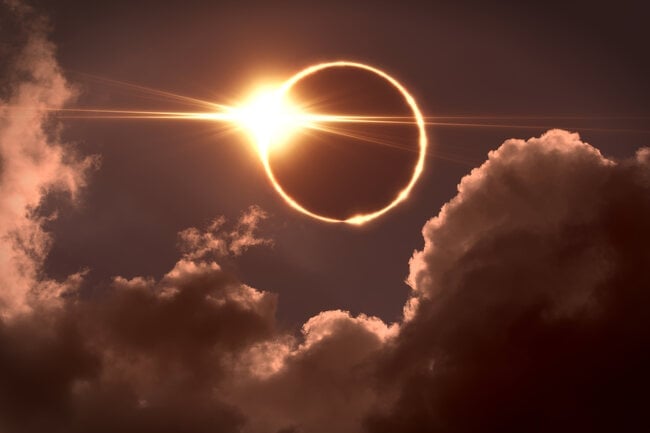
The Great Solar Eclipse 2024
Experience the awe-inspiring beauty of a total solar eclipse on April 8, 2024 – a date worth marking on your calendar. Better yet, consider planning a vacation around this celestial phenomenon. For optimal viewing conditions, our recommendation is to head to the Southwest, where the likelihood of clear skies is high. If you live in Texas, consider yourself fortunate, as you may not need to travel far! See the best viewing locations, times, and weather predictions for this year’s Great Solar Eclipse—as well as eclipse-themed party ideas here.
The path of totality begins in Mexico and runs northeast—across the United States—into Canada, specifically Ontario, Quebec, and the Maritimes.
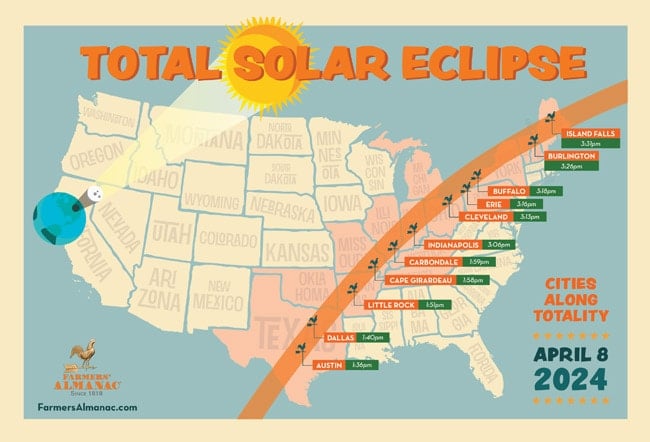
Don’t miss this unique opportunity!
The next chance to witness a total solar eclipse in North America won’t happen until March 2033–and that one requires travel to western Alaska. Following that, the wait extends to August 2044, when this spectacular celestial event graces parts of western Canada, Montana, and North Dakota.
Total Solar Eclipse 2024 Locations And Weather Predictions
Many places across North America will experience a partial eclipse, only those within a 125-mile-wide path will experience a truly brilliant cosmic performance. (Even in Toronto, where 99.8% of the Sun will be obscured, the tiniest dot of remaining sunlight will spoil the view.) Here are some select cities and Farmers’ Almanac regional forecasts for each:
|
Cities In The Path Of Totality
|
|||
|---|---|---|---|
| City | Totality begins (Local time) |
Duration of totality |
Weather Forecast |
| Austin, Texas | 1:36 p.m. | 1 min. 53 sec. | Fair for much of TX for eclipse, but clouds may be problematic for OK, AR. |
| Dallas, Texas | 1:40 p.m. | 3 min. 47 sec. | Fair for much of TX for eclipse, but clouds may be problematic for OK, AR. |
| Little Rock, Arkansas | 1:51 p.m. | 2 min. 33 sec. | Fair for much of TX for eclipse, but clouds may be problematic for OK, AR. |
| Cape Girardeau, Missouri | 1:58 p.m. | 4 min. 06 sec. | Generally dry, cool. MO has scattered clouds for eclipse-watchers. |
| Carbondale, Illinois | 1:59 p.m. | 4 min. 08 sec. | Eclipse-watchers in IL should get good views, but IN, KY, OH may not. Showers, thunderstorms increase from OH Valley, points east. |
| Indianapolis, Indiana | 3:06 p.m. | 3 min. 46 sec. | Eclipse-watchers in IL should get good views, but IN, KY, OH may not. Showers, thunderstorms increase from OH Valley, points east. |
| Cleveland, Ohio | 3:13 p.m. | 3 min. 50 sec. | Eclipse-watchers in IL should get good views, but IN, KY, OH may not. Showers, thunderstorms increase from OH Valley, points east. |
| Erie, Pennsylvania | 3:16 p.m. | 3 min. 43 sec. | Clouds likely to eclipse the eclipse for PA, NY, VT, NH, ME. Showers, thunderstorms possible. |
| Buffalo, New York | 3:18 p.m. | 3 min. 45 sec. | Clouds likely to eclipse the eclipse for PA, NY, VT, NH, ME. Showers, thunderstorms possible. |
| Hamilton, Ontario | 3:18 p.m. | 1 min. 45 sec. | Eclipse-watchers may not be fortunate, as showers and thunderstorms increase, sweep east. |
| Burlington, Vermont | 3:26 p.m. | 3 min. 14 sec. | Clouds likely to eclipse the eclipse for PA, NY, VT, NH, ME. Showers, thunderstorms possible. |
| Montreal, Quebec | 3:26 p.m. | 1 min. 12 sec. | Clouds likely to eclipse the eclipse for Montreal and the Maritimes. Showers and thunderstorms an increasing threat. |
| Island Falls, Maine | 3:31 p.m. | 3 min. 20 sec. | Clouds likely to eclipse the eclipse for PA, NY, VT, NH, ME. Showers, thunderstorms possible. |
| Fredericton, New Brunswick | 4:33 p.m. | 2 min. 16 sec. | Clouds likely to eclipse the eclipse for Montreal and the Maritimes. Showers and thunderstorms an increasing threat. |
| Tignish, Prince Edward Island | 4:35 p.m. | 3 min. 13 sec. | Clouds likely to eclipse the eclipse for Montreal and the Maritimes. Showers and thunderstorms an increasing threat. |
| Bonavista, Newfoundland | 5:13 p.m. | 2 min. 51 sec. | Sadly, widespread clouds probably will hide views of the totally eclipsed Sun for Newfoundland. Rain and wet snow. |
|
Cities Outside The Path Of Totality. (If you are based in any of these locations, you will want to travel closer to the any of the cities mentioned above to experience the grandeur of the Great Solar Eclipse 2024 event.)
|
||
|---|---|---|
| City | Maximum Eclipse (Local time) |
Percentage of Sun covered |
| Honolulu, Hawaii | 7:12 a.m. | 18 |
| Juneau, Alaska | 10:32 a.m. | 02 |
| Los Angeles, California | 11:12 a.m. | 49 |
| San Francisco, California | 11:13 a.m. | 34 |
| Seattle, Washington | 11:29 a.m. | 20 |
| Denver, Colorado | 12:40 p.m. | 65 |
| Mexico City, Mexico | 1:14 p.m. | 74 |
| New Orleans, Louisiana | 1:49 p.m. | 82 |
| Kansas City, Missouri | 1:54 p.m. | 90 |
| St. Louis, Missouri | 2:00 p.m. | 99 |
| Minneapolis, Minnesota | 2:02 p.m. | 74 |
| Chicago, Illinois | 2:07 p.m. | 94 |
| Miami, Florida | 3:01 p.m. | 46 |
| Atlanta, Georgia | 3:04 p.m. | 82 |
| Cincinnati, Ohio | 3:09 p.m. | 99 |
| Detroit, Michigan | 3:14 p.m. | 99 |
| Washington, D.C. | 3:20 p.m. | 87 |
| New York City, New York | 3:25 p.m. | 90 |
| Boston, Massachusetts | 3:29 p.m. | 93 |
Here’s a tip to remember: If you’re in St. Louis, Chicago, Cincinnati, or Detroit, you’re close to where the total eclipse happens, but not quite close enough to get the full experience. It’s like being right next to the Super Bowl but you can’t get into the stadium to see the game.
How El Niño May Affect Eclipse Views
Everyone’s buzzing with curiosity about where to catch the best view under clear skies. Now, here’s a weather twist: El Niño. El Niño is like a weather wildcard, a periodic ocean warm-up that can shake things up every couple of years. This year, it’s expected to hang out in the Northern Hemisphere from January to May, potentially mixing up the weather patterns we’re used to. This may affect gardening and fishing conditions.
Related: Farmers’ Almanac Daily Planner with the Best Days, Planting Calendar, and Fishing Calendar.
Historically, the southwest offers spectacular front-row seats for solar eclipses—especially in sunny Texas. But El Niño may reduce cloud cover in Oklahoma, Arkansas, Missouri, and Illinois by as much as 15 percent, which is great news for sky-watchers!
Related: Farmers’ Almanac Extended Weather Predictions For The Next 12 Months!
What Makes A “Total” Solar Eclipse Special?
A total solar eclipse occurs when the Moon entirely obscures the Sun, transforming day into night. As the sky darkens, stars illuminate the surroundings, creating a captivating spectacle. What distinguishes this celestial event is the emergence of the otherwise unseen outermost rays of the Sun, known as the corona. These rays radiate around the Moon, resembling a colossal halo of light that extends into space, reaching a distance up to five times the Sun’s diameter. While other types of eclipses may cast shadows and dim the sky, none quite match the awe-inspiring and otherworldly effect generated by a total solar eclipse.
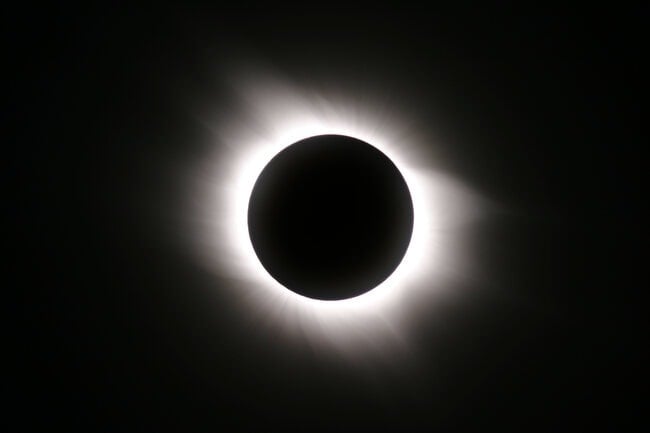
Eclipse Chasers
Some fans, often called “eclipse chasers,” really go the extra mile, setting up holiday plans and traveling far and wide to see as many eclipses as they can. This hobby needs a lot of commitment, since the Moon’s shadow sometimes falls over places that are remote and not easy to live in. You might wonder, why bother going on a trip just to see a total eclipse? The reason becomes obvious once you see it with your own eyes! (But don’t forget to put on the right kind of protective glasses.)
Related product: Farmers’ Almanac Solar Eclipse Glasses
A Bite Out Of The Sun?
Just a bit more than an hour before the grand finale, the total phase, the Moon will slip into place between the Sun and Earth. Picture it embarking on a leisurely journey across the Sun’s surface, creating the illusion of a cosmic bite being taken from our star—until the Sun seems to vanish entirely! Intriguingly, this celestial ballet prompted many cultures across the globe to conjure up tales of mythic beasts feasting on the Sun during an eclipse.
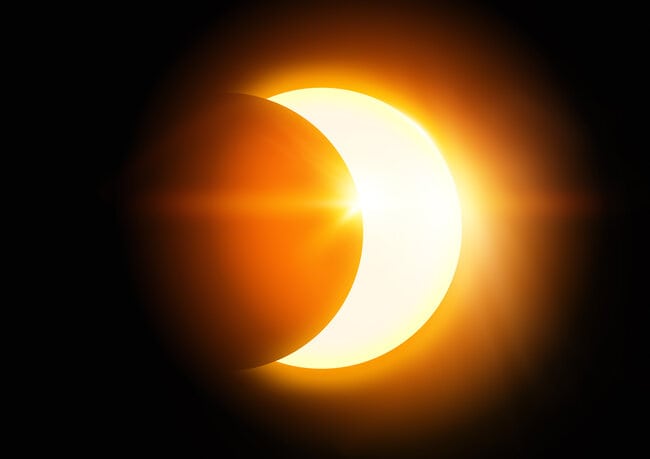
Strange, Flickering Shadows
Right before the total phase starts, the Sun turns into just a slim sliver of light. At this point, the Moon’s shadows on Earth look really special, unlike normal shadows. They show up as stripes of black and white, switching back and forth every couple of inches, making a sort of shimmering pattern on the ground. These are called “shadow bands,” and they’re these cool light patterns that happen because the little bit of sunlight squeezing past the Moon just before and right after a total eclipse gets bent as it moves through the air. (This bending is the same reason stars seem to twinkle in the night sky.)
Get Ready For The Diamond Ring Effect!
Right before everything goes dark during an eclipse, the last bits of sunlight that you can see around the Moon look like tiny dots or little ovals. These are known as “Baily’s Beads.” They seem to dance around, sometimes joining up or stretching out. This bizarre effect happens because of the way sunlight streams through the Moon’s uneven surface (the mountains and valleys at the edge).
At the same time, you can start to see the Sun’s outer atmosphere, called the corona, shining around the Moon’s dark shape. And then, for a few seconds, something amazing happens: One of those dots of sunlight sticks around, shining bright like a diamond. This creates a beautiful effect, like a giant diamond ring is floating in the sky. (The first picture in this story shows what it looks like.)
Day Becomes Night
As the last bit of light disappears, the Sun’s glow seems to suddenly vanish in complete silence, like everything’s been sucked into space. In those quick moments, the Sun’s inner atmosphere, the chromosphere, lights up with a beautiful red glow around the dark Moon, making a circle that looks like a bright red ring. Right after this stunning sight, you’ll see a soft glow, the corona, shining as bright as a full Moon.
The corona changes every time there’s an eclipse. It can look smooth and calm, or sometimes it sends out long beams in different directions. You might see it as straight lines sticking out from the Sun or ending in soft, brush-like shapes. Each time, it’s like a new work of art in the sky.
Venus, Jupiter, And The “Devil Comet” May Become Visible
As the Moon’s shadow covers the ground, some of the brightest stars and planets pop out, making for an amazing sky show. Venus steals the spotlight, shining brightly to the right (west) of the Sun that’s gone dark. On the other side, Jupiter glows to the left (east). There is also a chance that you may be able to see the “Devil Comet”—Learn how! The “Goat star” Capella, Mars, and Saturn might peek through now and then, but the corona’s shining light usually obscures stars, just like the bright light of a full Moon does.
Related: Farmers’ Almanac Monthly Stargazing Night Sky Guide
When it gets dark, nature reacts: birds head back to their nests, flowers gently shut, and animals settle down. This magical moment of total darkness lasts for about four minutes, and that’s when all these cool things happen. But just as quickly as it started, it ends, and the Moon’s shadow moves away to the northeast. The sky show goes in reverse: stars and planets fade, birds start chirping again, and nature wakes up.
Throw An Eclipse viewing Party!
Invite your loved ones for a sky-watching party to celebrate this rare event! It doesn’t matter if you’ve seen a solar eclipse before or if it’s your first time, throwing a party to watch it will be a memorable time, mixing natural beauty with fun times and tasty food. Here is a list of some essentials to get you started:
Eclipse Glasses: Give out special glasses made for watching the eclipse safely. They protect your eyes and let you see the eclipse clearly. Buy Farmers’ Almanac Solar Eclipse Glasses.
Telescopes or Binoculars with Filters: Have telescopes or binoculars ready with special filters so your guests can see the eclipse up close and check out the cool details like sunspots and the glowing halo around the Sun. Go to the Farmers’ Almanac “Starry Night Gift Guide” to see affordable telescope options.
Seating: Set up comfortable seats or bring blankets for guests to sit back and watch the eclipse. Blankets are great for sitting on the grass and keeping warm if it’s a bit chilly.
Sun Protection: If you’re outside, remind everyone to use sunblock and wear hats to guard against the Sun, especially when there’s still a lot of sunlight during the eclipse.
Drinks and Snacks: Fill coolers with tasty drinks and light snacks to keep everyone happy. Include things like water, fruit juices, soft drinks, and easy snacks such as fruit, sandwiches, and chips. See our list of special eclipse-related snacks below!
Shade: Put up some tents or big umbrellas for shade so people can take a break from the Sun and still enjoy the show.
Cameras and Tripods: Tell your guests to bring their cameras or phones with tripods to take pictures of the eclipse. Just remind them to use the right filters for their cameras, so they don’t hurt their eyes or break their gear.
Eclipse Guides: Hand out sheets with info about the eclipse, like when it starts, how long it lasts, and what makes a solar eclipse happen. This will help everyone understand and enjoy the event more. (Many cities are listed in our chart above, but if you would like more information about your particular location, ask your questions in the comments section below.)
With these items on your checklist, your guests can have a fun, comfy, and safe time watching the amazing solar eclipse.
Oh … and one last thing: Bring kazoos, noise-makers, or drums! According to folklore, making noise during a total solar eclipse ensures that the Sun returns to the sky! Speaking of sound …
Related: 10 Strange Facts About The Total Solar Eclipse 2024
Eclipse Party Playlist
Think about making special eclipse-related snacks and put together a great playlist of music for the event. Here are a handful of songs for your Solar Eclipse 2024 Party Playlist:
- “Total Eclipse of the Heart” – Bonnie Tyler
- “Moon Shadow” – Cat Stevens
- “Walking on the Moon” – The Police
- “Eclipse” – Pink Floyd
- “Blue Moon” – Elvis Presley
- “Fly Me to the Moon” – Frank Sinatra
- “Ain’t No Sunshine” – Bill Withers
- “Moon Dance” – Van Morrison
- “Dark Side of the Moon” – Pink Floyd
- “Here Comes the Sun” – The Beatles
- “Black Hole Sun” – Soundgarden
- “Dancing in the Dark” – Bruce Springsteen
- “Bad Moon Rising” – Creedence Clearwater Revival
- “Total Eclipse” – Iron Maiden
- “The Killing Moon” – Echo & the Bunnymen
- “Moonage Daydream” – David Bowie
- “Under the Milky Way” – The Church
Eclipse Party Foods
Make your eclipse-themed party even more special with these fun food ideas:
- Sun and Moon Cookies: Make cookies that look like Suns and Moons using sweet decorations like icing or chocolate.
- Eclipse Cupcakes: Make cupcakes with dark icing to show the eclipse’s shadow, and add a Sun or Moon shape on top with light-colored icing.
- Starry Popcorn: Make popcorn with black food dye and sparkly edible glitter to look like the night sky.
- Sunshine Fruit Sticks: Skewer yellow and orange fruits like pineapple, mango, and oranges to make snacks that look like the Sun.
- Moon Cheese Board: Put different cheeses in a Moon shape on a board, with crackers and nuts to eat with them.
- Space Snack Mix: Mix up dried fruit, nuts, and little chocolate pieces to make a snack that’s inspired by outer space.
- Moon Pies: Offer Moon pies as a sweet, old-fashioned treat.
- Star and Moon Shaped Fruits and Veggies: Cut fruits and veggies into stars and Moons for a creative healthy option.
- Crescent Rolls: Serve rolls shaped like a crescent Moon.
- Sun Chips: Sun Chips may be a healthier alternative to traditional potato chips (whole grain ingredients and lower fat content). Plus, the name is perfect for this kind of party!
- Starburst Sweets: Give out chewy, colorful Starburst candies for a tasty treat.
- Sunny Smoothies: Blend up smoothies or shakes with pineapple and banana for a refreshing drink.
- Eclipse Chewing Gum: Hand out gum with an eclipse theme as a playful party favor.
We hope these lists inspire you to be creative and have a fun a time! What songs, foods, or other items would you add? Share with your community here in the comments below …
Important Eye Safety Instructions
Do not look directly at the Sun (even when it is cloudy and the sunlight doesn’t seem to be as bright.) NASA says that it is okay to look at the eclipse without protective eyewear during the precise moment of totality, but Farmers’ Almanac does not recommend it. Staring at any part of the bright Sun with your naked eyes or a camera, binoculars, or a telescope that doesn’t have a special solar filter on the front can quickly and seriously hurt your eyes. Here are safer choices and important points to think about:
- Shadow Casting Method: Make a small hole or use a telescope to show the Sun’s picture on a piece of white cardboard.
- Welder’s Filter: You may look at the Sun through a special filter for welders, specifically No. 14 (or No. 12 if 80% of the Sun is hidden). Though we recommend taking extra precautions and ensuring that your filter is within the international safety standard guidelines.
- Don’t Use Poor Filters: Check your eclipse glasses or handheld sun viewer for damage like rips, scratches, or other problems before you use them. If you find any, throw them away right away. Also, always watch kids closely when they use these viewers. Steer clear of using things like darkened glass, overlapping polarizing filters, or water with color in it. They might seem to reduce the Sun’s brightness but can still let through harmful rays.
- Binoculars and Telescope Warning: Be very careful when using binoculars or telescopes. Never try to look at the Sun with a camera, telescope, binoculars, or any other device that makes things look closer while you’re wearing eclipse glasses or holding a Sun viewer. The strong sunlight can get through the filter and can hurt your eyes badly.Any filters should be placed on the front part where the light enters, not where you put your eye.
Please read more solar eclipse safety tips here (via American Astronomical Society)
A Final Thought On The Solar Eclipse 2024
We hope the total solar eclipse of April 2024 brings you a newfound appreciation of the wonder and mystery of the cosmos! For those journeying into the path of totality, good luck and may clear skies be before you!
Stay Up-To-Date on all things Astronomy! Sign-up for our Free Weekly E-newsletter at FarmersAlmanac.com/newsletter.
Follow us on Social Media: Facebook – Instagram – Pinterest – YouTube
Become a member of our site and get up to a year’s worth of Almanac calendars instantly at FarmersAlmanac.com/online-memberships
Join The Discussion
Are you located close to the path of totality?
Where are you planning to see the solar eclipse?
Share with your friends here in the comments below!

Joe Rao
Joe Rao is an esteemed astronomer who writes for Space.com, Sky & Telescope, and Natural History Magazine. Mr. Rao is a regular contributor to the Farmers' Almanacand serves as an associate lecturer for the Hayden Planetarium in New York City.



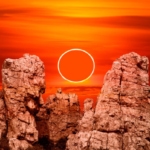
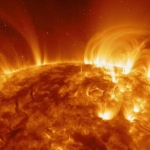
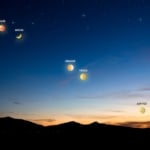
How does the shadow casting method work?
Fascinating…Looking forward to it
We are too!
Me TOO! it’s on my birthday!
It is my son’s 16th birthday!
Happy Eclipse Birthday to him!
wow
nice
good